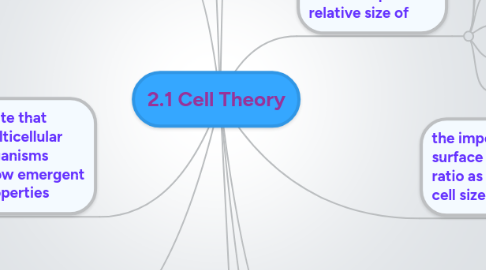
1. outline one therapeutic use of stem cells
1.1. Where are stem cells found?
1.1.1. in bone marrow
1.2. Where stem cells can be used?
1.2.1. in bone marrow transplants to treat people who have certain types of cancer
1.3. What can kill the cancer cells?
1.3.1. high doses of chemotherapy
1.3.2. the normal cells in the bone marrow
1.4. What can the patient do before he is treated with chemotherapy?
1.4.1. He can undergo a bone marrow harvest in which stem cells are removed from the bone marrow by using a needle which is inserted into the hip bone
1.4.2. What is an alternative way to get stem cells?
1.4.2.1. Stem cells can be harvested from a matching donor.
2. Evidence for the cell theory
2.1. Scientists found out all living organisms are made up of cells
2.2. IThrough experiment scientists proved that cells cannot arise from non-living material
3. State that multicellular organisms show emergent properties
3.1. Multicellular organisms show emergent properties
3.2. Multicellular orgamisms> organ system> organ> tissue> cell
4. State that unicellular organisms carry out all the functions of life
4.1. Metabolism: all chemical reactions which occur inside an organism
4.2. Response: (to the environment) is essential to survival
4.3. Homeostasis: Maintaining a constant internal environment e.g. temperature
4.4. Reproduction: hereditary molecules passed off to offspring
4.5. Growth: evident yet limited
5. State that stem cells retain the capacity to divide and have the ability to differentiate along different pathways
5.1. Stem cells are the very early undifferentiated cells
5.2. This means that they are able to differentiate into cells made for specific functions
5.3. For example, cells in bone marrow have the capacity to differentiate into both red blood cells and white blood cells.
6. by using the SI Units compare the relative size of
6.1. a molecule
6.1.1. 1 nm
6.2. thickness of cell membrane
6.2.1. 10 nm
6.3. viruses
6.3.1. 100 nm
6.4. bacteria
6.4.1. 1μm
6.5. eukaryotic cell
6.5.1. up to100 μm
6.6. organelles
6.6.1. up to 10 μm
7. Outline of cell theory
7.1. All living organisms are composed of cells.
7.2. Cells are the smallest unit of life.
7.2.1. New node
7.3. Cells come from pre-existing cells and cannot be created from non-living material.
8. the importance of the surface area to volume ratio as a factor limiting cell size
8.1. Surface area affects the rate at which particles can enter and exit the cell
8.1.1. If the surface area to volume ratio gets too small then substances won’t be able to enter the cell fast enough to fuel the reactions and waste products will start to accumulate within the cell as they will be produced faster than they can be excreted
8.2. volume affects the rate at which material are made or used within the cell, hence the chemical activity per unit of time
8.3. cells will not be able to lose heat fast enough and so may overheat.
8.4. the rate of heat production/waste production/resource consumption of a cell is a function of its volume, whereas the rate of exchange of materials and energy (heat) is a function of its surface area
9. cells in multicellular organisms differentiate to carry out specialized functions
9.1. Rather than all cells carrying out all functions, tissues and organs specialize to particular functions.
9.2. Specialized cells have switched on particular genes (expressed) that correlate to these specialist functions.
9.3. These specific gene expressions produce particular shapes, functions and adaptations within a cell.
9.4. It is an advantage for multicellular organisms as cells can differentiate to be more efficient
10. Calculate the linear magnification of drawings and the actual size of specimens in images of known magnification
10.1. Magnification
10.1.1. 1. Take measurement of the drawing (width or length)
10.1.2. 2. Take the same measurement from the specimen
10.1.3. 3. Convert units
10.1.4. Place values into the I AM calculation:
10.1.4.1. Magnification = Image size/actual size
10.1.4.2. Image size = actual size x magnification
10.1.4.3. Actual size = image size/magnification
